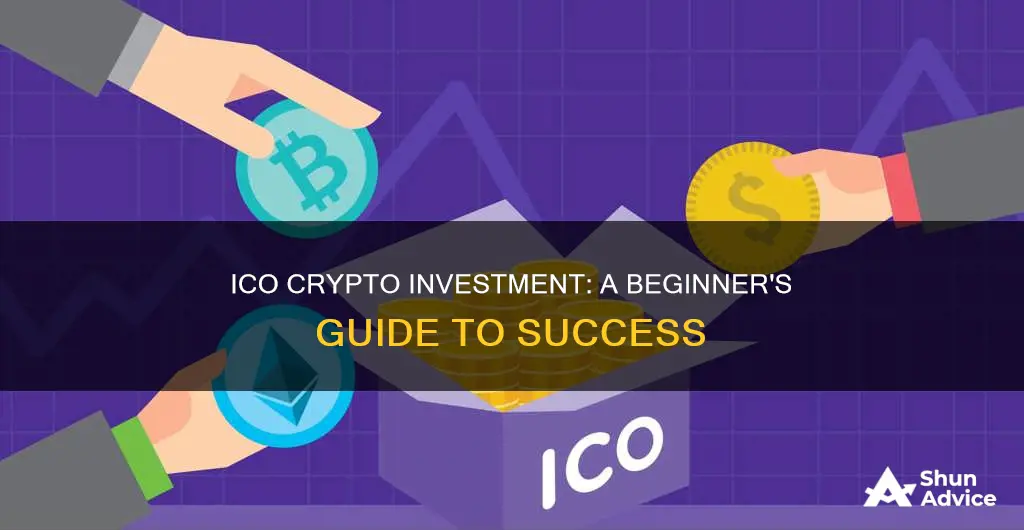
Investing in an ICO (Initial Coin Offering) is a risky but potentially rewarding endeavour. ICOs are the cryptocurrency industry's equivalent of an IPO (Initial Public Offering), where a company offers investors the chance to buy into a new blockchain app or service. The first step is to identify a legitimate ICO, as many are scams. Research the team behind the project, read the white paper, and consult crypto communities like Reddit and Bitcointalk. If you decide to invest, you'll need to buy Ethereum, set up a crypto wallet, and join a cryptocurrency exchange. It's important to only invest what you can afford to lose, as the crypto market is highly volatile.
| Characteristics | Values |
|---|---|
| Definition | Initial Coin Offering (ICO) |
| Similarity to IPO | Comparable to an IPO, but coins issued in an ICO can have utility for a software service or product |
| Purpose | A way for companies to raise funds for a blockchain and cryptocurrency project |
| Token Utility | Tokens may have utility related to the product or service offered by the company, or represent a stake in the company or project |
| Registration | In many cases, ICOs are security offerings and need to be registered |
| ICO Structure | Can be structured with static supply and static/dynamic price, static supply and dynamic price, or dynamic supply and static price |
| ICO Information | Companies usually create a pitchbook or white paper to explain important information related to the ICO, such as the project details, funding needs, token distribution, and payment methods |
| ICO Participation | Investors can use fiat or digital currency, including other forms of crypto like Bitcoin or Ethereum, to buy the new tokens |
| ICO Outcomes | If the ICO raises less than the minimum amount required, funds may be returned to investors. If funding requirements are met, the money is used to pursue the project's goals |
| ICO Launch | Anyone can launch an ICO, but regulators in developed nations monitor them closely to ensure compliance with registration requirements |
| ICO Research | When researching ICOs, evaluate the team composition, project's white paper, feedback from crypto communities, and the long-term use of funds |
| ICO Purchase Process | Read the token purchase procedure, open a supported wallet, join the exchange selling the tokens, and move the tokens to your wallet after purchase |
| ICO Profit Strategies | Sell the tokens when the price goes up or trade them in the markets by taking short or long-term positions |
| ICO Investment Considerations | Only invest what you can afford to lose, diversify your investments, and avoid borrowing money to invest in ICO tokens |
What You'll Learn

How to buy Ethereum
To buy Ethereum, you'll need to use a crypto exchange platform, such as Coinbase or Binance. Here's a step-by-step guide on how to buy Ethereum:
- Determine Your Level of Risk: Buying Ethereum can be a gamble as cryptocurrencies are vulnerable to price fluctuations. Consider your risk tolerance, the diversity of your investment portfolio, and the stability of your other investments before buying Ethereum.
- Choose a Crypto Exchange: You'll need to create an account on a crypto exchange platform. Some popular options include Coinbase and Binance.
- Create an Account: Sign up for an account on your chosen crypto exchange platform. You may need to provide a valid ID and proof of address to transact.
- Add a Payment Method: Connect a payment method to your account. You can typically use a bank account, debit card, or wire transfer.
- Select Ethereum: Search for Ethereum on the exchange platform and select it from the list of assets.
- Enter the Amount: Decide how much you want to buy and input the amount in your local currency. The platform will convert this into the equivalent amount of Ethereum.
- Finalize Your Purchase: Review the details of your purchase and confirm the transaction.
- Store Your Ethereum: After purchasing Ethereum, you can choose to store it on the exchange platform or transfer it to a third-party wallet. There are two types of third-party wallets: hot wallets, which are connected to the internet, and cold wallets, which are external devices disconnected from the internet.
It's important to carefully consider your investment decisions and understand the risks involved before purchasing any cryptocurrency.
Dogecoin Investment Guide: Getting Started and Strategies
You may want to see also

Setting up a crypto wallet
There are several types of crypto wallets, including hardware wallets and software wallets. Hardware wallets are physical devices like USB sticks that you can buy from manufacturers such as Ledger or Trezor. Software wallets, on the other hand, are created by the user and can be downloaded as apps on your phone or installed as browser extensions on your desktop.
- Choose between a custodial or non-custodial wallet. In a custodial wallet, a centralized authority (like a crypto exchange) controls your private keys and provides custody over your assets. With a non-custodial wallet, you keep control of your wallet's private keys.
- If you choose a hardware wallet, buy the device from the manufacturer or a trusted third party.
- Download the relevant wallet software. For example, if you bought a Ledger wallet, you would download Ledger Live.
- Connect your hardware wallet to your computer via USB.
- Choose a PIN to unlock your wallet.
- Save your recovery phrase. This will help you regenerate your wallet on a new device if your current one is lost or stolen. Be sure to write it down and keep it somewhere safe, but don't take a picture as it can be easily leaked or stolen.
- Confirm your recovery phrase by entering it again.
- If you are setting up a software wallet, download and install a wallet app from the App or Play Store. Popular options include Trust, Coinbase, MetaMask, and Atomic.
- Choose to create a new wallet and set a password or PIN to protect the app.
- Write down your recovery phrase and confirm it by entering it again.
Your crypto wallet is now ready to use! Remember to always back up your private keys and use two-factor authentication for added security.
Is Bitcoin a Safe Investment?
You may want to see also

Finding and researching ICOs
ICOs, or Initial Coin Offerings, are a popular way to raise funds for blockchain and cryptocurrency projects. They are the cryptocurrency industry's equivalent of an IPO (Initial Public Offering). Given the potential for high returns, it's no surprise that ICOs capture the attention of many crypto investors.
However, the ICO market is notoriously risky and unregulated, so it's crucial to conduct thorough research before investing. Here are some steps to help you find and evaluate potential ICO investment opportunities:
Understand the Basics
Before investing in ICOs, it's essential to grasp the fundamental concepts of blockchain, cryptocurrency, and ICOs themselves. Familiarize yourself with the unique characteristics of ICOs, such as their structure, fundraising methods, and the role of white papers. Understanding these basics will empower you to make more informed decisions.
Identify Sources of ICO Information
There are several online sources that can help you identify potential ICO opportunities. Start by exploring popular crypto forums, such as BitcoinTalk, Reddit, and Steemit, where you can discover what projects are generating buzz in the crypto community. Additionally, keep an eye on registered cryptocurrency exchanges to see what new coins they list, as they typically vet the coins before listing.
Conduct Due Diligence
When you've identified a few potential ICOs, it's time to dive deeper. Start by examining the white paper, which should outline the project's goals, technical specifications, roadmap, token information, and team. Assess whether the white paper is detailed, transparent, and straightforward. Be cautious if it lacks critical information or appears overly vague.
Evaluate the Development Team
Always research the development team behind an ICO. Look for teams with solid experience in the crypto and blockchain space. Check their social media presence and interactions with other professionals in the industry. Be wary of newly created social media accounts or inconsistencies in identities across different platforms, as these could be red flags.
Assess Community Support
A strong community backing for an ICO is often a positive sign. Explore platforms like GitHub, Slack, and Telegram to gauge the level of community engagement and support for the project. Active communities indicate that the project has attracted a dedicated following, which can be crucial for its long-term success.
Verify Venture Capital Funding
Communicate with the development team to understand the level of venture capital (VC) funding the project has secured. VC investors are experienced professionals who conduct thorough due diligence before investing. While they can sometimes be wrong, their involvement adds credibility to the project.
Cross-Reference Multiple Sources
Don't rely on a single source of information. Cross-reference your findings across multiple platforms and forums to ensure you're getting a comprehensive view of the ICO. This will help you identify potential red flags and increase your confidence in the investment opportunity.
Remember, investing in ICOs is a highly speculative endeavour, and scams are prevalent. Always proceed with caution, conduct your own due diligence, and only invest what you can afford to lose.
Ondo Coin: A Worthy Investment?
You may want to see also

Signing up and the KYC process
Signing up for an ICO can be a daunting process, but with some research and preparation, it can be a relatively straightforward experience. Here are the steps you need to take:
Understanding the Know Your Customer (KYC) Process
The KYC process is a critical aspect of the ICO process, as it helps companies verify the identity of their investors. While the specific requirements may vary depending on the ICO, it typically involves providing personal information and documents. In some cases, you may need to send a copy of your passport or a picture of yourself holding your identification document. The KYC process is essential to prevent money laundering and tax evasion, and with the increasing popularity of ICOs, regulators are mandating it more frequently.
Preparing Your Documents
Before signing up for an ICO, ensure you have all the necessary documents ready. This typically includes proof of identity, such as a passport or driver's license, and proof of address, such as a utility bill or bank statement. Some ICOs may also require a selfie or a short video for additional verification. It is important to refer to the specific ICO's requirements to ensure you have all the necessary documents.
Creating an Account
Most ICOs will require you to create an account on their platform. This usually involves providing your email address and creating a password. Some ICOs may also ask for additional information, such as your full name, date of birth, and country of residence. Make sure to use a secure password and enable two-factor authentication if available to protect your account.
Completing the KYC Process
Once you have created your account, you will need to complete the KYC process. Log in to your account and look for a section or tab labelled "KYC," "Verification," or something similar. Follow the instructions provided to upload your documents and complete the verification process. In some cases, the ICO may ask for additional information or documents, so be prepared to provide those if needed.
Waiting for Verification
After submitting your documents, the ICO will review and verify your information. This process can take varying amounts of time, depending on the ICO's volume and their internal processes. Some ICOs may provide an estimated timeline, while others may keep you updated via email or their platform. If there are any issues with your documents or additional requirements, the ICO will typically reach out to you.
Finalizing Your Investment
Once your KYC process is complete and your account is verified, you can finalize your investment. Follow the instructions provided by the ICO to purchase the tokens. This may involve sending funds to a designated address or using a supported cryptocurrency exchange. Make sure to carefully review the ICO's terms and conditions and investment procedures before finalizing your transaction.
Venus Coin: A Smart Investment Move?
You may want to see also

How to profit from an ICO
ICOs, or Initial Coin Offerings, are a popular way for companies to raise funds for products and services related to cryptocurrency. They are the cryptocurrency industry's equivalent of an IPO, or Initial Public Offering.
ICOs can be a great opportunity to profit, but it's important to remember that not all of them are legitimate. Here are some steps you can take to profit from an ICO:
Research the ICO Team and Project:
Look into the team members behind the ICO. Evaluate their commitment, skills, and past successes. You can find this information on social media or through the companies they work for. It's also important to read the project's white paper, which will outline the problem the project aims to address and how the ICO tokens will be used.
Assess the Long-Term Use of Funds:
A good sign of a legitimate ICO is one that directs funds towards project development. This shows a commitment to the long-term growth of the project, which can help raise the value of the tokens and provide a higher return on investment.
Understand the Token Purchase Procedure:
Each ICO will have its own process for selling tokens. Some may use a landing page where interested parties can purchase tokens with selected payment methods, while others may use crypto exchanges. Make sure to follow the prescribed procedure and be aware of any maximum or minimum token purchase limits.
Open a Supported Wallet:
You will need a crypto wallet to store your ICO tokens. Choose a wallet that supports the specific ICO token you plan to invest in, such as Ledger Nano S or MyEtherWallet. Remember to keep your private keys secure and never share them with anyone.
Join the Exchange and Purchase Tokens:
If the ICO tokens are being sold through a cryptocurrency exchange, you will need to create an account and fund it. You may need to convert your cash into a supported cryptocurrency, such as Bitcoin, before purchasing the ICO tokens.
Sell or Trade the Tokens:
Once you have purchased the ICO tokens, you can choose to sell them when the price goes up, or you can trade them on the markets. Trading involves taking short or long-term positions based on market trends, so it's important to educate yourself on how the market works and be aware of the risks involved.
Remember to only invest what you can afford to lose, as ICOs can be risky. By following these steps, you can increase your chances of profiting from an ICO while minimizing potential losses.
The Ultimate Guide to Bitcoin Investment
You may want to see also
Frequently asked questions
ICO stands for Initial Coin Offering. It is the cryptocurrency industry's equivalent of an initial public offering (IPO). Companies use ICOs to raise money to create a new blockchain app or service with a cryptocurrency.
ICOs are not easy to pick because they are entering the market at a rapid rate. To pick the right ICO to invest in, you should evaluate the ICO team composition, the project's white paper, what top crypto communities have to say about it, and the long-term use of the funds.
First, you need to buy Ethereum (ETH). Then, you need to set up a crypto wallet that supports receiving tokens. During an ICO, you send Ethereum to the company issuing a new token and receive the amount of tokens based on the announced exchange rate.
Once you have identified a good ICO, there are several ways to benefit from it. You can either sell the tokens when the price goes up, or trade the tokens in the markets.







